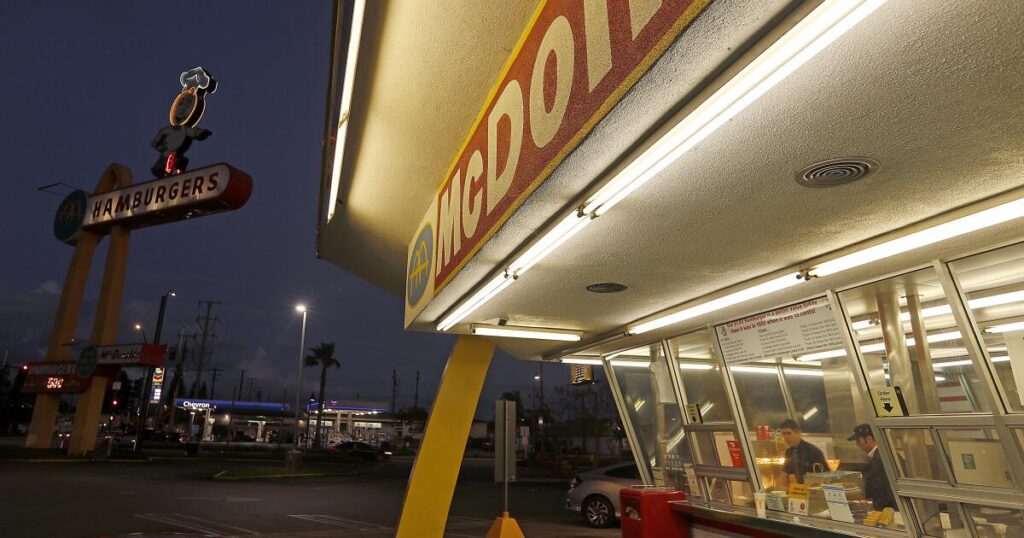In the early 2000s, after a severe slump, McDonald’s orchestrated a major turnaround, with the introduction of its Dollar Menu.
The menu, where all items cost $1, illustrated just how important it was to market to low-income consumers — who value getting the most bang for their buck.
Coming at a time of flagging growth, tumbling stock and the company’s first report of a quarterly loss, the Dollar Menu reversed the fast food giant’s bad fortune. It paved the way for three years of sales growth at stores open at least a year and ballooned revenue by 33%, news outlets reported at the time.
But no longer.
Prices have risen so high at the iconic fast food chain that traffic from one of its core customer bases, low-income households, has dropped by double digits, McDonald’s chief executive Christopher Kempczinski told investors last week. Meanwhile, traffic from higher-earners increased by nearly as much, he said.
The struggle of the Golden Arches — long synonymous with cheap food for the masses — reflects a larger trend upending the consumer economy and making “affordability” a hot policy topic.
McDonald’s executives say the higher costs of restaurant essentials, such as beef and salaries, have pushed food prices up and driven away lower-income customers who are already being squeezed by the rising cost of groceries, clothes, rent and child care.
With prices for everything rising, consumer companies concerned about the pressures on low-income Americans include food, automotive and airline businesses, among others, said analyst Adam Josephson. “The list goes on and on,” he said.
“Happy Meals at McDonald’s are prohibitively expensive for some people, because there’s been so much inflation,” Josephson said.
Josephson and other economists say the shrinking traffic of low-income consumers is emblematic of a larger trend of Americans diverging in their spending, with wealthier customers flexing their purchasing power and lower-income shoppers pulling back — what some call a “K-shaped economy.”
A recent earnings report from Delta offers yet another illustration. While Delta’s main cabin revenue fell 5% for the June quarter compared to a year ago, premium ticket sales rose 5%, highlighting the divide between affluent customers and those forced to be more economical.
At hotel chains, luxury brands are holding up better than low budget options. Revenue at brands including Four Seasons, Ritz-Carlton and St. Regis is up 2.9% so far this year, while economy hotels saw a 3.1% decline for the same period, according to industry tracker CoStar.
“There are examples everywhere you look,” Josephson said.
Consumer credit delinquency rates show just how much low-income households are hurting, with households that make less than $45,000 annually seeing “huge year-over-year increases,” even as delinquency rates for high- and middle-income households have flattened and stabilized, said Rikard Bandebo, chief strategy officer and chief economist at VantageScore.
After COVID-19-related stimulus programs ended, these households were the first to see dramatically increased delinquency rates, and haven’t seen a dip in delinquencies since 2022, according to data from VantageScore on 60-day past-due delinquencies from January 2020 to September 2025. And although inflation has come down from its peak in 2022, people are still struggling with relatively higher prices and “astronomical” rent increases, Bandebo said.
A report released this year by researchers with Joint Center for Housing Studies at Harvard University found that half of all renters, 22.6 million people, were cost-burdened in 2023, meaning they spent more than 30% of their income on housing and utilities, up 3.2 percentage points since 2019 and 9 percentage points since 2001. Twenty-seven percent of renters are severely burdened, spending more than 50% of their income on housing.
As rents have grown, the amount families have left over after paying for housing and utilities has fallen to record lows. In 2023, renters with annual household incomes under $30,000 had a median of just $250 per month in residual income to spend on other needs, an amount that’s fallen 55% since 2001, with the steepest declines since the pandemic, according to the Harvard study.
“It’s getting tougher and tougher every month for low-income households to make ends meet,” Bandebo said.
Prices at limited-service restaurants, which include fast-food restaurants, are up 3.2% year over year, at a rate higher than inflation “and that’s climbing” said Marisa DiNatale, an economist at Moody’s Analytics.
On top of that, price increases due to tariffs disproportionately affect lower-income households, because they spend a greater portion of their income on goods rather than services, which are not directly impacted by tariffs. Wages too, are stagnating more for these households compared to higher- and middle-income households, DiNatale said.
“It has always been the case that more well-off people have done better. But a lot of the economic and policy headwinds are disproportionately affecting lower-income households, and [McDonald’s losing low-income customers] is a reflection of that,” DiNatale said.
It makes sense, then, that any price increases would hit these consumers hard.
According to a corporate fact sheet, from 2019 to 2024, the average cost of a McDonald’s menu item rose 40%. The average price of a Big Mac in 2019, for example, was $4.39, rising in 2024 to $5.29, according to the company. A 10-piece McNuggets Meal rose from $7.19 to $9.19 in the same time period.
The company says these increases are in line with the costs of running a restaurant — including soaring labor costs and high prices of beef and other goods.
Beef prices have skyrocketed, with inventory of the U.S. cattle herd at the lowest in 75 years due to the toll of drought and parasites. And exports of beef bound to the U.S. are down because of Trump’s trade war and tariffs. As a result, the prices of ground beef sold in supermarkets is up 13% in September, year over year.
McDonald’s has also placed blame on the meat-packing industry, accusing it of maneuvering to artificially inflate prices in a lawsuit filed last year against the industry’s “Big Four” companies — Tyson, JBS, Cargill and the National Beef Packing Company.
The companies have denied wrongdoing, and paid tens of millions of dollars to settle multiple lawsuits alleging price-fixing.
However, McDonald’s chief financial officer Ian Borden said on the recent earnings call that the company has managed to keep expenses from getting out of control.
“I think the strength of our supply chain means our beef costs are, I think, certainly up less than most,” he said.
McDonald’s did not disclose how the company gauges the income levels of their customers but businesses often analyze the market area they serve by estimating the background of their customers based on where they are shopping and what they are buying.
In California, the debate around fast food prices has centered on labor costs, with legislation going into effect last year raising the minimum wage for fast-food workers at chains with more than 60 locations nationwide.
But more than a year after fast-food wages were boosted, the impact is still being debated, with economists divided and the fast-food industry and unions sparring over its impact.
Fast-food restaurant owners as well as trade associations like the International Franchise Assn., which spearheaded an effort to block the minimum wage boost, have said businesses have been forced to trim employee hours, institute hiring freezes or lay people off to offset the cost of higher wages.
Meanwhile, an analysis by researchers at UC Berkeley’s Center on Wage and Employment Dynamics of some 2,000 restaurants found the $20 wage did not reduce fast-food employment, and “led to minimal menu price increases” of about 8 cents on a $4 burger.”
Labor groups have also argued that minimum wage increases give workers more purchasing power, helping to stimulate the economy.
McDonald’s said last year that spending by the company on restaurant worker salaries had grown around 40% since 2019, while costs for food, paper and other goods were up 35%.
The success of its Dollar Menu in the early 2000s was remarkable because it had come amid complaints of the chain’s highly processed, high-calorie and high-fat products, food safety concerns and worker exploitation.
As the company marketed the Dollar Menu, which included the double cheeseburger, the McChicken sandwich, french fries, a hot fudge sundae and a 16-ounce soda, it also added healthier options to its regular menu, including salads and fruit.
But the healthier menu items did not drive the turnaround. The $1 double cheeseburgers brought in far more revenue than salads or the chicken sandwiches, which were priced in the $3 to $4.50 range.
“The Dollar Menu appeals to lower-income, ethnic consumers,” said Steve Levigne, vice president for United States business research at McDonald’s, told the New York Times in 2006. “It’s people who don’t always have $6 in their pocket.”
The Dollar Menu eventually became unsustainable, however. With inflation driving up prices, McDonald’s stores, particularly franchisee locations, struggled to afford it, and by November 2013 rebranded it as the “Dollar Menu & More” with prices up to $5.
Last year, McDonald’s took a stab at appealing to cash-stretched customers with a $5 deal for a McDouble or McChicken sandwich, small fries, small soft drink and four-piece McNuggets. And in January it rolled out a deal offering a $1 menu item alongside an item bought for full price, with an ad starring John Cena, and launched Extra Value Meals in early September — offering combos costing 15% less than ordering each of the items separately.
The marketing didn’t seem to immediately cut through to customers, with McDonald’s in May reporting U.S. same-store sales in the recent quarter declined 3.6% from the year before. However, in its recent third-quarter earnings, the company reported a 2.4% lift in sales, even as its chief executive sounded the alarm about the increasingly two-tiered economy.
That other businesses, too, are reviving deals is a sign of the times. San Francisco-based burger chain Super Duper promoted its “recession combo” on social media. For $10, customers get fries, a drink and a “recession burger” at one of the chain’s 19 California locations.
What’s clear is companies are wary of passing along higher costs to customers, said DiNatale, of Moody’s Analytics.
“A lot of businesses are saying, we just don’t think consumers will stand for this,” DiNatale said. “[Consumers] have been through years of higher prices, and there’s just very little tolerance for higher prices going forward.”
The post McDonald’s is losing its low-income customers. Economists call it a symptom of the stark wealth divide appeared first on Los Angeles Times.




